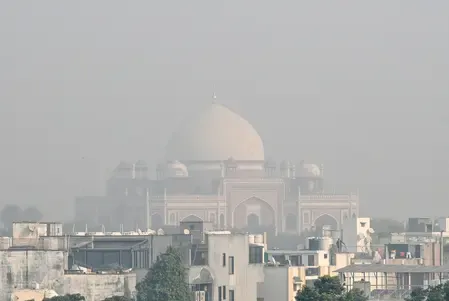Is Delhi's Air Quality Crisis Deepening Again?

Synopsis
Key Takeaways
- Delhi's AQI has reached an alarming level of 385.
- Cold wave conditions are worsening the air quality crisis.
- The CAQM will only reimpose restrictions if AQI exceeds 400.
- Health experts recommend staying indoors and avoiding outdoor activities.
- Stagnant winds are contributing to the accumulation of pollutants.
New Delhi, Nov 28 (NationPress) On Friday, residents of Delhi woke up to yet another day of hazardous air, with the Air Quality Index (AQI) reaching 385, placing it firmly in the “very poor” classification. The air pollution situation across Delhi-NCR remains alarming, providing little relief to citizens already grappling with a cold wave.
The increase in pollution levels comes just a day after the authorities lifted the Graded Response Action Plan (GRAP) Stage-III restrictions, which are implemented to tackle severe pollution episodes. However, this brief respite was short-lived, as the air quality deteriorated significantly once again. On Thursday, the overall AQI for the city surged to 377, up from 327 the day before, highlighting a sharp decline in air quality within just 24 hours.
Despite these escalating conditions, the Commission for Air Quality Management (CAQM) has stated that Stage-III restrictions will only be reinstated if the AQI exceeds 400, categorizing it as “severe”. Until that threshold is reached, authorities plan to keep monitoring the situation without enforcing stricter measures.
The Central Pollution Control Board (CPCB) reported that pollution levels increased steadily throughout Thursday due to persistently low wind speeds. The AQI, which was 351 at 8 am, climbed to 381 by 7 pm, indicating an ongoing accumulation of pollutants in the area.
Meteorologists have indicated that the winds remained nearly stagnant for most of the day, with only brief gusts at 4–5 km/h, insufficient to disperse the particulate matter. Forecasts suggest that the national capital is likely to remain in the “very poor” category for the coming days.
Meanwhile, the cold wave affecting Delhi and surrounding cities is exacerbating the crisis. The combination of low temperatures, fog, and high pollution levels is worsening public health outcomes.
In Delhi-NCR and various cities across North India, the temperature has plummeted to a minimum of 8 to 12 degrees Celsius.
A thick veil of haze covered the city from the morning into the evening, significantly reducing visibility on the roads and contributing to slower traffic.
Health experts caution that inhaling such polluted air can have serious health implications, especially for children, the elderly, and those with respiratory or cardiac conditions. They advise residents to remain indoors as much as possible, avoid intense outdoor activities, and venture out only when absolutely necessary.









